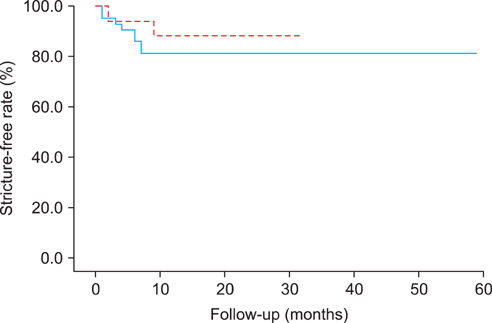Korean J Urol.
2012 Aug;53(8):569-572.
Comparison of Immediate Primary Repair and Delayed Urethroplasty in Men with Bulbous Urethral Disruption after Blunt Straddle Injury
- Affiliations
-
- 1Department of Urology, CHA Bundang Hospital, CHA University College of Medicine, Seongnam, Korea. urojin@cha.ac.kr
Abstract
- PURPOSE
The aim of this study was to analyze the outcomes of immediate primary repair (IPR) compared with delayed repair (DR) after initial suprapubic cystostomy.
MATERIALS AND METHODS
We reviewed the records of 60 patients with bulbous urethral disruption after blunt trauma from February 2001 to March 2011. Seventeen patients who presented in an acute injury state underwent IPR; 43 patients underwent DR after the initial suprapubic cystostomy. None of the patients had undergone previous urethral manipulation. We compared the outcomes, including stricture, impotence, and incontinence, between the two management approaches. We also measured the time to spontaneous voiding, the duration of suprapubic diversion, and the number of days spent in the hospital.
RESULTS
The median follow-up was 20.5 months (range, 13 to 59 months; mean, 23.3 months). Among 17 patients in the IPR group, strictures developed in 2 patients (11.7%), and among 53 patients in the DR group, strictures developed in 8 patients (18.6%, p=0.709). The incidences of impotence and incontinence were similar in both groups (17.6% and 0% in the IPR group vs. 27.9% and 4.6% in the DR group, p=0.520 and 1.000, respectively). The time to spontaneous voiding and the duration of suprapubic diversion were significantly shorter in the IPR group (average 27.3 and 33.4 days, respectively) than in the DR group (average 191.6 and 198.1 days, respectively; p<0.001 and <0.001).
CONCLUSIONS
IPR may provide comparable outcomes to DR and allow for shorter times to spontaneous voiding and reduce the duration of suprapubic diversion.
MeSH Terms
Figure
Reference
-
1. Mundy AR, Andrich DE. Urethral trauma. Part I: introduction, history, anatomy, pathology, assessment and emergency management. BJU Int. 2011. 108:310–327.2. Koraitim MM. Pelvic fracture urethral injuries: the unresolved controversy. J Urol. 1999. 161:1433–1441.3. Chapple C, Barbagli G, Jordan G, Mundy AR, Rodrigues-Netto N, Pansadoro V, et al. Consensus statement on urethral trauma. BJU Int. 2004. 93:1195–1202.4. Armenakas NA, McAninch JW. McAninch JW, editor. Acute anterior urethral injuries: diagnosis and initial management. Traumatic and reconstructive urology. 1996. Philadelphia: Saunders;543–561.5. Martinez-Pineiro L, Djakovic N, Plas E, Mor Y, Santucci RA, Serafetinidis E, et al. EAU Guidelines on Urethral Trauma. Eur Urol. 2010. 57:791–803.6. McAninch JW. Traumatic injuries to the urethra. J Trauma. 1981. 21:291–297.7. Hadjizacharia P, Inaba K, Teixeira PG, Kokorowski P, Demetriades D, Best C. Evaluation of immediate endoscopic realignment as a treatment modality for traumatic urethral injuries. J Trauma. 2008. 64:1443–1449.8. Moore EE, Cogbill TH, Jurkovich GJ, McAninch JW, Champion HR, Gennarelli TA, et al. Organ injury scaling. III: chest wall, abdominal vascular, ureter, bladder, and urethra. J Trauma. 1992. 33:337–339.9. Rosenstein DI, Alsikafi NF. Diagnosis and classification of urethral injuries. Urol Clin North Am. 2006. 33:73–85. vi–vii.10. Pontes JE, Pierce JM Jr. Anterior urethral injuries: four years of experience at the Detroit General Hospital. J Urol. 1978. 120:563–564.11. Hernandez J, Morey AF. Anterior urethral injury. World J Urol. 1999. 17:96–100.12. Ku JH, Kim ME, Jeon YS, Lee NK, Park YH. Management of bulbous urethral disruption by blunt external trauma: the sooner, the better? Urology. 2002. 60:579–583.13. Ying-Hao S, Chuan-Liang X, Xu G, Guo-Qiang L, Jian-Guo H. Urethroscopic realignment of ruptured bulbar urethra. J Urol. 2000. 164:1543–1545.14. Kotkin L, Koch MO. Impotence and incontinence after immediate realignment of posterior urethral trauma: result of injury or management? J Urol. 1996. 155:1600–1603.15. Mouraviev VB, Coburn M, Santucci RA. The treatment of posterior urethral disruption associated with pelvic fractures: comparative experience of early realignment versus delayed urethroplasty. J Urol. 2005. 173:873–876.16. Park S, McAninch JW. Straddle injuries to the bulbar urethra: management and outcomes in 78 patients. J Urol. 2004. 171(2 Pt 1):722–725.17. Webster GD, Mathes GL, Selli C. Prostatomembranous urethral injuries: a review of the literature and a rational approach to their management. J Urol. 1983. 130:898–902.18. Patterson DE, Barrett DM, Myers RP, DeWeerd JH, Hall BB, Benson RC Jr. Primary realignment of posterior urethral injuries. J Urol. 1983. 129:513–516.19. Koraitim MM. Pelvic fracture urethral injuries: evaluation of various methods of management. J Urol. 1996. 156:1288–1291.


